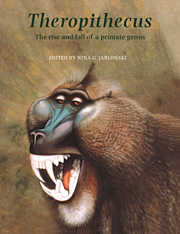Book contents
- Frontmatter
- Contents
- List of Contributors
- Preface
- Acknowledgements
- 1 Introduction
- PART I Fossil evidence and phylogeny
- PART II Biogeography and evolutionary biology
- PART III Anatomy of the fossil and living species of Theropithecus
- 10 Allometric aspects of skull morphology in Theropithecus
- 11 Evolution of the masticatory apparatus in Theropithecus
- 12 Dental microwear and diet in extant and extinct Theropithecus: preliminary analyses
- 13 The development and microstructure of the dentition of Theropithecus
- 14 Postcranial anatomy of extant and extinct species of Theropithecus
- PART IV Behaviour and ecology of living and fossil species of Theropithecus
- Appendix I A partial catalogue of fossil remains of Theropithecus
- Appendix II Conservation status of the gelada
- Index
10 - Allometric aspects of skull morphology in Theropithecus
Published online by Cambridge University Press: 11 November 2009
- Frontmatter
- Contents
- List of Contributors
- Preface
- Acknowledgements
- 1 Introduction
- PART I Fossil evidence and phylogeny
- PART II Biogeography and evolutionary biology
- PART III Anatomy of the fossil and living species of Theropithecus
- 10 Allometric aspects of skull morphology in Theropithecus
- 11 Evolution of the masticatory apparatus in Theropithecus
- 12 Dental microwear and diet in extant and extinct Theropithecus: preliminary analyses
- 13 The development and microstructure of the dentition of Theropithecus
- 14 Postcranial anatomy of extant and extinct species of Theropithecus
- PART IV Behaviour and ecology of living and fossil species of Theropithecus
- Appendix I A partial catalogue of fossil remains of Theropithecus
- Appendix II Conservation status of the gelada
- Index
Summary
Summary
Reliable quantitative comparisons of living and fossil Theropithecus with other primates require attention to non-linear scaling effects of body size. With special reference to Old World monkeys, allometric scaling analyses were conducted on (a) length of the upper cheek toothrow, (b) basal area of the upper canine, (c) sexual dimorphism in body weight, and (d) brain size.
Papio and Theropithecus both have relatively long cheek toothrows in comparison to other Old World monkeys, whereas colobine monkeys have relatively short toothrows. Because Papio and Theropithecus have comparatively large cheek teeth, associated with relatively long jaw length and overall skull length, the use of craniodental dimensions for the inference of body weight in fossil Theropithecus is problematic. It is hence preferable to apply scaling formulae determined exclusively for members of the baboon group (Mandrillus, Papio, Theropithecus) for this purpose (e.g. Dechow, 1983).
Relative to the general scaling relationship for Old World monkeys, there is no evidence of reduction of overall canine size in extant Theropithecus. Appropriate scaling studies are required to determine whether there has been reduction in relative size of the canines in fossil Theropithecus, as has been claimed. Modern Theropithecus show an interesting sexual difference: females have strikingly slender canines, relative to body size, in comparison to males and in comparison to other Old World monkeys. But canine length has not been reduced in female Theropithecus in comparison to other Old World monkeys. It remains to be determined whether this marked sexual difference in relative calibre of the canines also applies to fossil Theropithecus.
[…]
- Type
- Chapter
- Information
- TheropithecusThe Rise and Fall of a Primate Genus, pp. 273 - 298Publisher: Cambridge University PressPrint publication year: 1993
- 14
- Cited by



